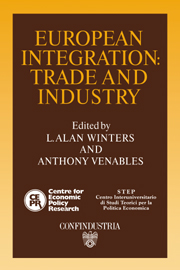Book contents
- Frontmatter
- Contents
- List of figures
- List of tables
- Preface
- Acknowledgements
- List of conference participants
- 1 European integration: trade and industry
- 2 Completing the internal market in the EC: factor demands and comparative advantage
- Discussion
- 3 External effects and Europe's integration
- Discussion
- 4 The quality and production of textiles and clothing and the completion of the internal market
- Discussion
- 5 Competition and imports in the European market
- Discussion
- 6 The structure and determinants of East–West trade: a preliminary analysis of the manufacturing sector
- Discussion
- 7 1992 and EFTA
- Discussion
- 8 Technology policy in the completed European market
- Discussion
- 9 Corporation tax, foreign direct investment and the single market
- Discussion
- 10 Japanese direct manufacturing investment in Europe
- Discussion
- Index
6 - The structure and determinants of East–West trade: a preliminary analysis of the manufacturing sector
Published online by Cambridge University Press: 07 September 2010
- Frontmatter
- Contents
- List of figures
- List of tables
- Preface
- Acknowledgements
- List of conference participants
- 1 European integration: trade and industry
- 2 Completing the internal market in the EC: factor demands and comparative advantage
- Discussion
- 3 External effects and Europe's integration
- Discussion
- 4 The quality and production of textiles and clothing and the completion of the internal market
- Discussion
- 5 Competition and imports in the European market
- Discussion
- 6 The structure and determinants of East–West trade: a preliminary analysis of the manufacturing sector
- Discussion
- 7 1992 and EFTA
- Discussion
- 8 Technology policy in the completed European market
- Discussion
- 9 Corporation tax, foreign direct investment and the single market
- Discussion
- 10 Japanese direct manufacturing investment in Europe
- Discussion
- Index
Summary
Introduction
Since the autumn of 1989, important political changes have taken place in eastern European countries and in the USSR. These changes are far from completed and much uncertainty remains with respect to the speed at which reforms will proceed, as well as to the content of the reforms. However, it is uncontroversial at this point to presume that some form of a market system for goods and factors will be established and that trade between eastern European countries and the rest of the world is likely to be liberalised. In this study, we shall assume that this reform has indeed been implemented and we shall focus on its consequences for western European countries. We will try to assess how the liberalisation of trade will affect the EC countries and whether the ‘1992’ programme of integration could be jeopardised by such liberalisation.
The consequences for western Europe of liberalising trade with the East are, in principle, relatively straightforward (see Smith and Venables, 1988, or Norman, 1989): as barriers to trade between the East and western Europe are removed, one can expect that the comparative advantage between the East and western Europe will be further exploited and accordingly that inter-industry trade will develop between the two areas. Between countries having similar factor endowments, one can also expect that scale economies will be further exhausted and hence that intra-industry trade will increase.
- Type
- Chapter
- Information
- European IntegrationTrade and Industry, pp. 96 - 115Publisher: Cambridge University PressPrint publication year: 1991
- 2
- Cited by

